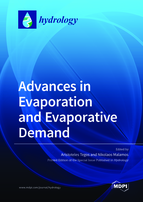Advances in Evaporation and Evaporative Demand
A special issue of Hydrology (ISSN 2306-5338). This special issue belongs to the section "Hydrological and Hydrodynamic Processes and Modelling".
Deadline for manuscript submissions: closed (31 January 2022) | Viewed by 40266
Special Issue Editors
2. Ryan Hanley Ltd. Ireland, 170/173 Ivy Exchange, Granby Pl, Parnell Square W, D01 N938 Dublin, Ireland
Interests: hydrology; floods; remote sensing
Special Issues, Collections and Topics in MDPI journals
Interests: hydrology; hydroinformatics; irrigation; simulation
Special Issues, Collections and Topics in MDPI journals
Special Issue Information
Dear Colleagues,
The importance of evapotranspiration is well-established in different disciplines such as hydrology, agronomy, climatology, and other geosciences. Reliable estimates of evapotranspiration are also vital to develop criteria for in-season irrigation management, water resource allocation, long-term estimates of water supply, demand and use, design and management of water resources infrastructure, and evaluation of the effect of land use and management changes on the water balance. The objective of this Special Issue is to define and discuss several ET terms, including potential, reference, and actual (crop) ET, and present a wide spectrum of innovative research papers and case studies. We, therefore, encourage researchers and experts to present their innovative contributions in the following areas:
- New techniques for estimating evapotranspiration and comparative analysis of different evapotranspiration models
- New methodologies for estimating evapotranspiration and evaporation in temporal time scales from hourly to monthly
- Global and local calibration of parsimonious PET model in data scarce areas using limited climate data
- Advanced techniques for quantifying evapotranspiration spatial variability
- Calibration of large-scale hydrological model using evapotranspiration spatial products
- Micrometeorological evapotranspiration modeling focusing on smart farming
- Modeling Evapotranspiration for precision irrigation purposes
- Weather forecasting model associated with the hydrological modelling and optimal irrigation scheduling
- Remote Sensing application for evapotranspiration assessment
- Public available hydrological and agronomical software incorporating evapotranspiration modeling
- Effect of evapotranspiration in drought modeling
- Irrigation management and evapotranspiration assessment
- Crop coefficients and Eddy measurements
- Use of evapotranspiration in climatic studies and long-term climatic trend analysis
Dr. Aristoteles Tegos
Dr. Nikolaos Malamos
Guest Editors
Manuscript Submission Information
Manuscripts should be submitted online at www.mdpi.com by registering and logging in to this website. Once you are registered, click here to go to the submission form. Manuscripts can be submitted until the deadline. All submissions that pass pre-check are peer-reviewed. Accepted papers will be published continuously in the journal (as soon as accepted) and will be listed together on the special issue website. Research articles, review articles as well as short communications are invited. For planned papers, a title and short abstract (about 100 words) can be sent to the Editorial Office for announcement on this website.
Submitted manuscripts should not have been published previously, nor be under consideration for publication elsewhere (except conference proceedings papers). All manuscripts are thoroughly refereed through a single-blind peer-review process. A guide for authors and other relevant information for submission of manuscripts is available on the Instructions for Authors page. Hydrology is an international peer-reviewed open access monthly journal published by MDPI.
Please visit the Instructions for Authors page before submitting a manuscript. The Article Processing Charge (APC) for publication in this open access journal is 1800 CHF (Swiss Francs). Submitted papers should be well formatted and use good English. Authors may use MDPI's English editing service prior to publication or during author revisions.
Keywords
- Evapotranspiration
- Hydrology
- Agronomy
- Remote Sensing







